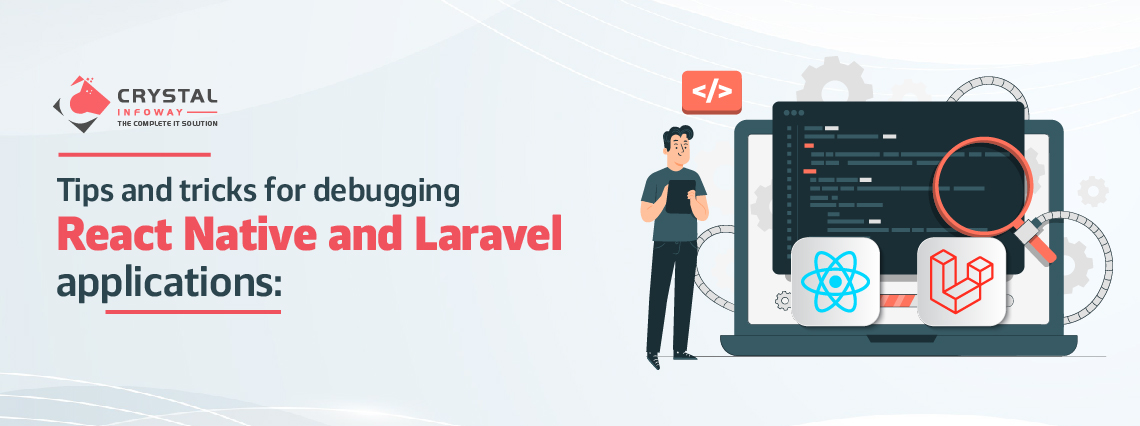
Request a Call Back
Enter your contact details and one of our friendly team member will be in touch soon!.

Enter your contact details and one of our friendly team member will be in touch soon!.

Debugging is an essential part of software development, and React Native and Laravel are two popular technologies used for building mobile and web applications respectively. Debugging can be challenging at times, but with the right tips and tricks, it can become a smoother and more efficient process. In this blog, we will discuss tips and tricks for debugging React Native and Laravel applications to help developers identify and fix issues more effectively.
React Native is a popular framework for building cross-platform mobile applications using React, a JavaScript library for building user interfaces. Here are some tips for debugging React Native applications:
1. Use Debugging Tools: React Native comes with built-in debugging tools that can help you identify and fix issues in your application. One such tool is the React Native Debugger, which is a standalone app that allows you to inspect and debug your React Native code. You can use it to view the state and props of your components, monitor network requests, and track performance issues. Another useful tool is the React Native Developer Menu, which can be accessed by shaking your device while your app is running. The Developer Menu provides options for debugging, such as enabling remote debugging, reloading the app, and toggling performance overlays.
2. Utilize Console Logging: Console logging is a powerful tool for debugging React Native applications. You can use the console.log() function to print values, objects, and error messages to the console, which can help you understand the flow of your application and identify issues. You can also use a console.warn() and console.error() to log warnings and errors, respectively. Additionally, you can use the debugger statement in your code to trigger a breakpoint and pause the execution of your app, allowing you to inspect the state and props of your components at that particular point in time.
3. Use React Native Debugger: React Native Debugger is a standalone debugging tool that provides a comprehensive set of features for debugging React Native applications. It allows you to inspect and modify the state and props of your components, view network requests and responses, monitor performance, and analyze the layout of your components. You can also set breakpoints in your code, step through the execution, and analyze the call stack to identify and fix issues.
4. Check for Error Messages: React Native provides error messages in the console and on the device screen when an error occurs. These error messages can provide valuable information about the cause of the issue, such as the location of the error in the code, the type of error, and the stack trace. Make sure to check the error messages in the console and on the device screen, and use them as clues to identify and fix the issue.
5. Check Props and State: Props and state are two important concepts in React Native applications. Props are used to pass data from parent components to child components, while the state is used to manage the internal state of a component. When debugging React Native applications, it's important to check the values of props and states at different points in the application's lifecycle. You can use console.log() or the React Native Debugger to inspect the values of props and state and ensure that they are being passed and updated correctly.
6. Review Code and Dependencies: Sometimes, issues in React Native applications can be caused by incorrect code or incompatible dependencies. When debugging, review your code and dependencies to ensure that they are correctly implemented and up-to-date. Check for any syntax errors, logical errors, or misconfigurations in your code, and make sure that your dependencies are compatible with the version of React Native you are using. Also, check for any deprecated APIs or outdated libraries that may be causing issues.
Debugging Laravel applications can be a challenging task, but with the right tools and techniques, you can make the process more efficient and effective. Here are some tips for debugging Laravel applications:
1. Use Laravel's Built-in Debugging Tools Laravel comes with several built-in debugging tools that can help you identify and fix errors in your code. Some of these tools include:
The Laravel Debug bar: This package provides a toolbar that displays information about your application's queries, routes, and more. You can use it to identify slow queries, debug middleware, and more.
The Laravel Telescope: This package provides a powerful debugging and profiling tool that allows you to monitor the performance of your application in real time. You can use it to track requests, monitor cache usage, and more.
The Laravel Log Viewer: This package provides a graphical interface for viewing and filtering your application's log files. You can use it to identify errors and debug issues that occur during runtime.
2. Use Debugging Statements Laravel provides several debugging statements that you can use to print messages and variables to the console or log files. Some of these statements include:
dd(): This statement dumps the given variables and ends the execution of the script. It's useful for inspecting the contents of variables and identifying errors.
dump(): This statement dumps the given variables to the console or log file. It's useful for inspecting the contents of variables without stopping the script.
logger(): This statement writes a message to the log file. It's useful for debugging issues that occur during runtime
3. Use Error Handling Laravel provides a comprehensive error handling system that can help you identify and handle errors in your application. You can use the try-catch block to catch exceptions and handle them in a way that's appropriate for your application. Additionally, Laravel's error-handling system provides several useful features, such as sending email notifications when errors occur, logging errors into the database, and displaying custom error pages.
4. Check Your Code for Common Errors Many errors in Laravel applications are caused by common mistakes, such as typos, syntax errors, and incorrect data types. To minimize these errors, it's a good idea to regularly check your code for common mistakes and use tools like linting and static analysis to identify potential issues before they become problems.
5. Using a Good IDE can make debugging much easier and more efficient. IDEs like Visual Studio Code and PhpStorm come with powerful debugging tools that allow you to step through your code, set breakpoints, and inspect variables and objects in real time. Additionally, these IDEs often provide helpful error messages and suggestions that can help you fix issues more quickly and efficiently
In conclusion, debugging Laravel applications can be a complex and time-consuming process, but by using the right tools and techniques, you can make it more manageable and effective. Use Laravel's built-in debugging tools, debugging statements, and error handling, check your code for common errors, and use a good IDE to streamline your debugging process and ensure that your applications run smoothly and efficiently. I hope these tips and tricks help you with debugging your React Native and Laravel applications!


Introduction React Native is a popular ...
Read More
Are you looking for top Website developmen...
Read More
Laravel is a PHP-based web framework for b...
Read More